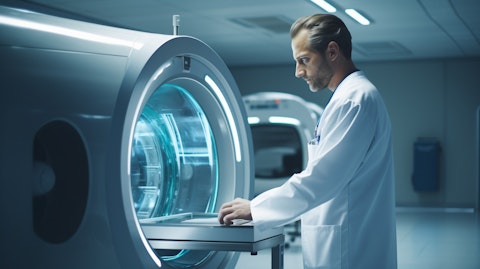Profound Medical Corp. (NASDAQ:PROF) Q3 2025 Earnings Call Transcript November 13, 2025
Profound Medical Corp. beats earnings expectations. Reported EPS is $-0.26, expectations were $-0.38.
Operator: Good day, and thank you for standing by. Welcome to the Profound Medical Third Quarter 2025 Financial Results Conference Call. [Operator Instructions] Please be advised that today’s conference is being recorded. I would now like to hand the conference over to your first speaker today, Stephen Kilmer, Investor Relations. Please go ahead.
Stephen Kilmer: Thank you. Good afternoon, everyone. Let me start by pointing out that this conference call will include forward-looking statements within the meaning of applicable securities laws in the United States and Canada. All forward-looking statements are based on Profound’s current beliefs, assumptions, and expectations, and relate to, among other things, any expressed or implied statements regarding future financial performance and position and expectations regarding the efficacy of Profound’s technologies in the treatment of prostate cancer, benign prostate hyperplasia or BPH, uterine fibroids, adenomyosis, pain palliation of bone metastases, desmoid tumors, osteoid osteoma and the potential treatment of abdominal cancers and hypothermia for cancer therapy.
Such statements involve known and unknown risks, uncertainties and other factors that may cause actual results, performance or achievements to be materially different from those implied by such statements. No forward-looking statement can be guaranteed. Listeners are cautioned not to place any undue reliance on these forward-looking statements, which speak only as of the date of this conference call. Profound undertakes no obligation to publicly update or revise any forward-looking statement, whether as a result of new information, future events or otherwise, other than as required by law. Representing the company today are Dr. Arun Menawat, Profound’s Chief Executive Officer; Rashed Dewan, the company’s Chief Financial Officer; Dr. Mathieu Burtnyk, Profound’s President; and Tom Tamberrino, our Chief Commercial Officer.
With that said, I’ll now turn the call over to Rashed.
Rashed Dewan: Good afternoon, everyone, and welcome to our third quarter 2025 conference call. On behalf of the management team and everyone at Profound, I would like to thank you for your ongoing interest in our company. For those of you who are shareholders, we appreciate your continued interest and support. I will turn the call over to Mathieu in a moment to provide commercial updates. However, before I do, I would like to provide a brief summary of our third quarter 2025 financial results. To streamline things, all of the numbers I will refer to have been rounded, so they are approximate. For the 3-month period ended September 30, 2025, the company recorded revenue of $5.3 million, with $4.1 million from recurring revenue and $1.2 million from onetime sale of capital equipment.
Third quarter 2025 revenue was up 87% from $2.8 million for the same 3-month period a year ago. Gross margin in Q3 2025 was 74.3% compared to 63.1% in Q3 2024. Total operating expenses in the 2025 third quarter, which consists of R&D and SG&A expenses, were $12.8 million compared with $10.8 million in the third quarter of 2024. Overall, the company recorded the third quarter 2025 net loss of $8 million or $0.26 per common share, down from a net loss of $9.4 million or $0.38 per common share for the same 3-month period in 2024. As of September 30, 2025, Profound had cash of $24.8 million. As Arun will discuss later in the call, we believe that we are now on a path to profitable growth. In keeping with that, we expect our cash burn to decline and eventually turn cash flow positive with — as our revenue continues to grow and our margins remain high.
That said, we have recently received some inquiries about potential future financing plans, and if we have a shelf registration statement filed in the U.S. With respect to our thoughts on future financing. While we have not made any current plans, we’d like to assure investors that we will continue to be opportunistic with the goal of limiting shareholder dilution as much as is practicable. And with respect to a shelf, we do not currently have one in place, but plan to file an S-3 later this evening as a matter of good corporate housekeeping to keep our options open as we move forward with our financial growth. With that, I will now turn the call over to Mathieu for an update on clinical and development activities.
Mathieu Burtnyk: Thank you, Rashed, and good afternoon. Last quarter, we initiated the pilot release of our new TULSA-AI Volume Reduction software, which is specifically designed to shrink benign and large prostates primarily caused by the condition known as BPH. I am delighted to announce today that the full product release will be launched at this year’s annual meeting of the Radiological Society of North America, or RSNA, which is taking place in Chicago at the end of this month. The new volume reduction software leverages AI-powered planning and accelerated ablation together with the same TULSA hardware, the same regulatory indication for use and the same reimbursement codes to provide fast and efficient workflows, which are on par with mainstream BPH treatment options.
The pilot release has 2 primary objectives. The first was to demonstrate total procedure time of 60 to 90 minutes and the second was to obtain early user feedback to incorporate into the complete feature set included in the full product release. Both of these objectives have been resolutely met. To date, early surgeon feedback has exceeded our expectations. With the precision of real-time MRI guidance and the flexibility of transurethral ultrasound ablation, surgeons have described that they can create treatment designs that mimic any other BPH procedure, whether it’s coring the apple like Rezum and Aquablation or a more complete resection like HoLEP. In other words, no matter the prostate shape or size and the needs of the patient for a small or large ablation, TULSA with volume reduction can do it.
TULSA also goes beyond with the ability to precisely carve out the ejaculatory ducts, visualize and target cancer lesions, or even prophylactically ablate regions suspicious for cancer, such as PI-RADS 3 lesions or in patients with high PSA or that have a known genetic risk. Surgeons have also described how they can use the efficiency benefits of the new software features for patients with prostate cancer. With the improved workflows and flexibility to customize each treatment to the individual patient, surgeons will have the ability to create what they call TULSA days, where they stack multiple cases in 1 day with predictable and efficient outcomes, whether with prostate cancer, BPH or patients with both cancer and BPH. And that is all with no overnight stay, no blood loss, no fulguration, no grade 4 adverse events, and no need for patients to discontinue their anticoagulant therapy.
The pilot launch of the volume reduction software has motivated incremental increase in BPH procedures from Q2 to Q3 and into the first half of Q4. With the full product launch at RSNA later in November, we believe we are well positioned to demonstrate increased utilization in BPH with double-digit percentages of our total procedures in 2026. Speaking of RSNA, we’re just 2 short weeks away from the meeting in Chicago, where the TULSA-PRO will be featured prominently. Our booth will feature the full product launch of our new TULSA-AI Volume Reduction software and the final perioperative outcomes from the CAPTAIN trial will be presented by Dr. Peji Ghanouni from Stanford. In addition, the Innovation Theater will host a special session titled Discover TULSA-PRO, AI-powered, MRI-guided precision prostate ablation, which will be presented by both Dr. Joseph Busch from the Busch Center as well as Dr. Daniel Costa from the MD Anderson Cancer Center.
In a separate session, Dr. Busch will deliver an oral presentation describing his TULSA outcomes from a cohort of 160 patients. And finally, the TULSA procedure will be the subject of 3 different educational exhibits from each, the University of Texas Southwestern, the NIH or the National Institute of Health, as well as from the Sapporo Hokuyu Hospital in Japan. We certainly look forward to an impactful event. I would like to take a moment to provide an update on our CAPTAIN trial. During our last earnings call, we announced that the CAPTAIN trial was fully recruited and all patient treatments were complete, making it the first randomized controlled trial ever comparing a new technology to the standard of care of robotic radical prostatectomy to successfully recruit to target.
We believe one of the reasons for the success is the capability of TULSA to perform safe and effective whole gland ablations, making it a true incision-free prostatectomy as opposed to other ablative procedures that can only target small unifocal disease. Completion of all patient treatment marks a significant milestone as it cements the timing of data readout, including the primary 1-year safety and 3-year efficacy outcomes. The trial, however, is already collecting important secondary endpoints. The final perioperative outcomes will be presented at RSNA as well as at the Society of Urological Oncology, or SUO, in early December. The data will prove TULSA’s superiority to robotic surgery and blood loss, hospital stay, post-op pain, and time of recovery.

This will be followed closely by its peer-reviewed publication, which we expect to be submitted to a scientific journal before the end of this year, which we believe will be the beginnings of a key driver towards gaining favorable recommendation from the relevant professional society treatment guidelines and positive reimbursement coverage from private payers. Since RSNA starts in just a few days and CAPTAIN side effect data would have been needed to have been submitted prior to any presentation, it won’t be part of what’s presented there this year. However, we are considering appropriate ways to unveil it relatively soon without risking breaking any embargoes ahead of AUA in May. So please, stay tuned on that front. And with that, I’ll turn the call over to Tom.
Thomas Tamberrino: Thank you, Mathieu. In Q3 2025, we continue to build on the commercial momentum we established earlier this year. We saw strong traction with our TULSA-PRO platform. As Rashed mentioned earlier, we achieved a year-over-year revenue increase of 87%, up from $2.8 million in Q3 2024. Our gross margin also improved significantly, reaching 74% compared to 64% last year. This reflects the growing efficiency and scale of our commercial operations. As of now, we have 70 TULSA-PRO sites. And the company’s TULSA-PRO qualified sales pipeline is also growing and currently stands at 93 new systems being classified within one of the Verify, Negotiate and Contracting stages, which are the final 3 phases of our sales process.
Q3 was a true commercial inflection point. We’re seeing broader adoption of TULSA-PRO across both academic and community hospitals. That’s largely due to increased awareness of the system’s clinical benefits and the streamlined reimbursement pathway made possible by the Category 1 CPT code. Our team remains focused on targeting high-volume urology centers and supporting physician training. We’re leveraging positive clinical outcomes and patient testimonials to drive engagement and deepen relationships with our customers. Looking ahead, I’m confident in our ability to sustain this growth. We are well positioned to capitalize on the expanding interest in image-guided interventions, and we’re continuing to scale our commercial footprint while validating our technology in the prostate care market.
We have established flexible business models to drive adoption. With our 25 for 200 program, hospitals performed 25 cases in year 1 for roughly $200,000 with a path to capital conversion. This model allows hospitals to break even on a per procedure basis, typically by the 12th case, while providing Profound with committed revenue. Our standing pricing model includes a capital system priced around $500,000 and disposables averaging $5,500 per procedure. We’re seeing success at our model sites. In Texas, the Prime hospital system is demonstrating Medicare profitability. And in the near future, we are confident that our TULSA Plus sites will prove that integration with [ iMRI ] can deliver a payback in under 2 years. Rather than competing with HIFU, IRE or cryo physicians, we’re collaborating with them.
These clinicians already prefer alternatives to radical prostatectomy or radiation, but their current options limit patient volume. TULSA’s versatility enhances their offerings and over time, many of them gravitate toward adopting our technology. We’re also building strategic partnerships on a global basis, whether that be through distribution agreements with the likes of Al Faisaliah Medical Systems in Saudi Arabia, Getz Healthcare in Australia and New Zealand or partnerships with OEMs such as Siemens. There’s more to come on the partnership front, and I’m excited about the opportunities ahead. Thank you for your time. I will now turn the call over to Arun.
Arun Menawat: Thank you, Tom, and good afternoon, everyone. As you just heard from Tom, after experimentation and refinement, both his team and their messaging to potential customers, we now know how to sell TULSA programs. As I have presented earlier this week at the Stifel conference, we believe we are now on a path to not just grow, but profitably grow. The math to achieve this target is simple. With this 200 TULSA programs using existing MR installed base, assuming 50 TULSA procedures per site per year and 5,500 in recurring revenue to Profound procedure, we would be at $55 million in procedure revenue, about $10 million in annual service revenue and selling 40 TULSA-PRO systems per year at $500,000, $20 million in new capital revenue.
That will put us around $85 million annual revenue. With 70-plus percent gross margin already achieved, we would be profitable well before that. Putting this together, with what Mathieu has already discussed, the trifecta is finally here. The MR is here and high MRI is coming rapidly. In the very near term, our strategy is to focus on existing MRs and achieve an installed base of 200 TULSA-PRO sites. That is where our sales team is focused right now. Simultaneously, we are in the final stages of achieving comparative — compatibility with the new Siemens Interventional MR, the Free.Max. We believe that as early as next year, TULSA Plus sites with Free.Max plus TULSA-PRO will be operational, opening the door to the future, the interventional MR suite with TULSA.
These sites will further streamline the patient and staffing workflow, making it easier to further drive adoption. Second, we are now beginning to get confirmation from multiple hospitals that they are being paid to all — for all qualified Medicare patients and that they are satisfied with the amount received. In addition, many commercial payers are also now covering the procedure on a case-by-case basis. In some cases, that’s based on pre-approvals. In some cases, they are being submitted after the procedure and being paid. And in others, there are initial denials, but we are getting reversals through appeal. So while that is still a bit of a mixed bag at this stage, as we have said earlier, we’re tracking appropriately at this stage and remain confident that we will begin to secure national or regional coverage decisions from the commercial payers starting middle of next year as there is an ample clinical data to support our applications.
Third, we are excited to be upgrading our AI-powered software to include simpler patient workflow for patients who suffer from BPH symptoms. Having the flexibility to treat a variety of patients with prostate cancer and now with BPH gives our sites the flexibility to create a treatment day which leads to efficiency and easier scheduling for the hospital staff. We believe that altogether, this trifecta gives us a good chance to not only grow in high double-digits, but with high margins, we believe we can achieve profitability and continue to grow profitably. Before my closing remarks, I would like to take a few moments to talk about our second large opportunity, Sonalleve. We’re getting more and more incoming calls from both TULSA users and non-TULSA sites that are interested in interventional MRI and the ability to also treat diseases in the body cavity such as diseases of the uterine adenomyosis and fibroids and cancers such as liver and pancreatic cancers.
In fact, FMS, who we announced an exclusive distribution agreement with, for Saudi Arabia, earlier this week originally called us about Sonalleve. Once they were introduced to TULSA-PRO as well, they quickly wanted to discuss both and not only for Saudi Arabia, but also potentially other countries they’re active in, such as other Gulf region countries and Brazil, where they own multiple hospitals. Sonalleve, which is offered primarily as a onetime capital sale, uses the same MR imaging and thermography technology as TULSA-PRO and combines that with focused ultrasound from outside the body to treat disease. There are currently 10 Sonalleve devices operational in parts of Europe, China and Southeast Asia, where over 4,000 women have already been treated with the technology for adenomyosis and uterine fibroids, diseases of the uterus that can cause chronic pain and heavy and/or prolonged menstruations.
Treatment with Sonalleve has demonstrated pain and symptom relief without affecting the ovarian reserve and with reports of women preserving their fertility. Sonalleve is also now being used in research and clinical trials in Europe for the ablation of pancreatic cancer, tissue and other oncological diseases. To summarize, Profound is the only company that combines the real-time imaging and thermography capabilities of MR and AI-driven treatment designs to allow physicians to precisely and gently address disease tissue without any incision, associated tissue boiling or charring, blood loss, severe or prolonged pain, or need for overnight hospital stay The sales team is clearly delivering and the pipeline, as we define it, now over 50 as compared to 80 in mid-August.
TULSA-PRO installed base now sits at 70, and we expect to reach at least 75 installs by the end of the year. The new TULSA-AI Volume Reduction module to treat patients with BPH symptoms in significantly reducing the procedure time, making it very competitive with other BPH treatment technologies. This application has the potential to add 400,000 patients to our annual TAM, essentially tripling our previous TAM. Adding the BPH module also enables physicians to create a full TULSA day during which both their prostate cancer patients and BPH patients are treated. From the perspective of ease of scheduling and creating a TULSA program, this ability is important. The second technology platform, Sonalleve, is poised to start becoming a more core part of our story in the coming months and quarters, both internationally and in the United States.
And finally, as user interest in Profound’s technologies continues to build, we’re deploying our own direct sales team in North America while partnering with select strategic distribution partners to support the business potential and the customer base in other parts of the world for both TULSA-PRO and Sonalleve. This ends our prepared remarks for today. With that, we’re happy to take any questions you might have. Operator?
Operator: [Operator Instructions] Our first question comes from Ben Haynor of Lake Street Capital Markets.
Q&A Session
Follow Profound Medical Corp. (NASDAQ:PROF)
Follow Profound Medical Corp. (NASDAQ:PROF)
Receive real-time insider trading and news alerts
Benjamin Haynor: First off for me, just very encouraging to see the utilization jump up in Q3 after kind of a frustrating first half of the year. And it does sound, based upon your [ commentary ] in the press release that, that trend continues into Q4 thus far. Could you provide a little bit more color and maybe characterize how that’s tracking?
Arun Menawat: Yes. Ben, I’m going to let Tom answer that because [ he’s ] a fantastic pipeline. So Tom, if you could please go ahead.
Thomas Tamberrino: Yes, happy to, Ben. Thank you for the question. So to make sure I’m hearing it correctly, specifically, you’re calling out the improvement in utilization, right, treatments that have been completed here in Q3 and whether we have experienced that trend continuing to date through the beginning part of Q4. Is that correct?
Benjamin Haynor: Yes. Basically, are you seeing that acceleration continue as we close out the year?
Thomas Tamberrino: So the answer is yes. And what I can tell you is that the tailwinds that are coming online are the fact that the CPT1 coding that we’ve referred to and the reimbursement associated with that through Medicare is coming through exactly as we thought it would. So, there’s tremendous validity in terms of the ability to provide treatment to men who are Medicare eligible. Added to which indignity, our market access and patient access team are doing a tremendous job of working with individual patients on obtaining private insurance coverage on a one-to-one basis in the absence of any payer policies, right? We don’t have any negative payer policies or positive payer policies at this time. And we have a corporate strategy to address that with the private payers as well.
So what’s happening is we’ve got the tailwind of Medicare patients coming online, right, moving away from a cash pay-only market. We’ve got individual wins with private insurance companies. And added to that, we’ve got a growing body of evidence, as has been stated through not only the Busch press release that came out, but also several others that there’s an appetite for this technology across the globe. And I’m not sure if you’ve met urologists, but they’re a competitive bunch. So, one country wants to get started before another country. And that also comes back to the U.S. as well where if you’ve trained with another physician during your days in fellowship or residency and they’re using it in a country that is not this country, there’s competitive juices flowing.
So there’s a multiple factors that are going into driving that adoption. And let’s not forget the most important reason why, is that patients are seeking TULSA-PRO out based on their own research and identification of the results of other men who have faced prostate disease. That is our greatest referral base.
Benjamin Haynor: Excellent. That’s very helpful. And then on the folks that have gotten commercial payers to pay and typically, you see commercial rates roughly double Medicare rates. Is that about what you’ve seen? Is — Do you have sufficient experience there to make any comments?
Arun Menawat: Yes. Ben — Mathieu, I know you have some numbers too, but we are starting to get a number of sites that are willing to share the numbers and the Medicare numbers are definitely where they are supposed to be, but the numbers from private payers are significantly higher. And Mathieu, if you have some numbers, please, go ahead and talk about that.
Mathieu Burtnyk: Yes, absolutely. So we are — to Arun’s point, we are starting to get some information from some of our sites as we’re working with them on ensuring all of their charges are set up properly and so on. And the volume of Medicare patients is higher than the commercial ones that are getting approved. But even from a Medicare perspective, there’s a site that’s kind of call it national average. They have confirmed that they are receiving about $13,000 for Medicare as well as Medicare Advantage patients, which is right along the CMS rule. And for commercial payers, I was actually surprised to see it. I mean, this is a one particular site. I don’t know if it’s necessarily applicable to all sites around the country, but they’re seeing payments like payment dollars from like $25,000 all the way up to $65,000 per patient.
And — so when you look at sort of the contribution margin from those, again, even on the Medicare and Medicare Advantage, they’re actually making sort of $3,000 to $4,000 per patient in a contribution margin perspective. And then, of course, those that are — the payers that are paying in that $25,000 to $65,000 range, then it’s much more significant there. So seeing very, very positive numbers from those sites that are willing to share that information with us, and that’s an initiative that we’re going to continue to go through in Q4 of this year as well as into 2026.
Benjamin Haynor: That’s great. And then lastly for me and then I’ll jump back in queue. You got 93 folks — 93 sites that are in the engage stage. How many of those do you expect to kind of fall out and ultimately become customers? And any — over what time period sort of information that you could share there would be fantastic.
Thomas Tamberrino: Thank you, Ben, I know you would do the same for me if I maybe misstated. So I want to make sure we clarify, these are in the Verify, Negotiate and Contracting phases, which is the tail end of our pipeline that then leads into closing, right? The engage portion is further up the pipeline. So this is a much different subset of accounts that we’re referring to.
Benjamin Haynor: Okay. So [indiscernible] how do you [indiscernible] to kind of fall out?
Thomas Tamberrino: Arun?
Arun Menawat: Yes. I mean I think, Ben, the way to think about this, this is a real pipeline, which is why, as Tom described, we are making it available because I realize everyone is wondering how real the future look like, and it’s kind of highly vetted pipeline. I think 2 things. One is that it does give us good confidence for the Q4 growth. And I think the — for the 2026, I don’t think they’re all going to close in 1 quarter, obviously. But I think the way to think about this is 2025 Q4, the pipeline [indiscernible] will close. And then 2026, we’re starting with a really good pipeline to be able to continue to grow.
Operator: And our next question is coming from John McAulay of Stifel.
John McAulay: I wanted to start off today just on setting expectations for the fourth quarter. Again, apologies if I missed it, but in the past, you’ve talked about 70% to 75% growth for the year. And now with the strong 3Q report, the — there’s a smaller implied step-up to get to that range. Just wanted to hear your general thoughts as we head into the fourth quarter and expectations in terms of the revenue and whether that 70%, 75% guidance still stands?
Arun Menawat: Yes. John, that’s a great question. I think that based on the information we have provided, Tom and the team have already closed 3 sites, which is why our installed base is now at 70. Hopefully, that gives you some confidence. And then the pipeline information hopefully gives you confidence as well. And so, where we are, we remain comfortable with that 70% growth target. We have delivered the first quarter with growth. We think we can deliver the second quarter with growth and then continued growth. So I think bottom line, John, we’re comfortable with that 70% growth target.
John McAulay: Got it. That’s helpful. And as a follow-up, gross margins stepped up again, now a little over 74% here. Can you just talk about the capital versus consumable dynamic? What’s driving the acceleration? And what’s a reasonable long-term target here?
Arun Menawat: I think we are more likely than not probably at the right place on gross margin. The reality is that the margin is about the same on both the recurring revenue as well as the capital. And so, John, I would say, using a number between 70% to 75%. We always thought we would get above 70%. We are kind of feeling like this is about where we would like to be running the business in the low 70% range.
John McAulay: Just if I could sneak in one more. It’s a follow-up on Ben’s question at the beginning.
Arun Menawat: Yes, please.
John McAulay: In the 3 stages of the negotiation or in the contracting that you’re talking about, these 3 latter stages, just want to put a finer point on — I mean, what’s the fallout rate here from stage to stage? So for the one that’s in the final [indiscernible], what sort of percent closing rate are you seeing? Before that, what’s the percent chance that it reaches that final stage of the pipeline and so on and so forth? You see what I’m getting at?
Arun Menawat: So — yes, I do. I understand that very well. So I would say given that we are — the pipeline is new and so on, our ability to really predict a specific is not as high because we have less data. But from our history, from our prior company and so on, I would say that for the next couple of quarters, we think that, that sort of pipeline in the 50-plus percent range is — will ultimately close. We think, as our sales team gets more experience, that number will more than likely increase to 65%. So, this is where — we don’t put things into that tail end until we have at least a 50% confidence that they will close.
Operator: [Operator Instructions] Our next question will be coming from Michael Freeman of Raymond James.
Michael Freeman: Congratulations on these big results. Just detail, I’m curious, you mentioned 70 total units installed. With your pre-announcement, you mentioned 67. Is the 70 units total installed, is that as of today’s date? Or was — did this happen in Q3?
Arun Menawat: That’s right, Michael. The team really has been working pretty hard. So the first 3 deals of this quarter already closed. And so that’s why we decided we would share with you what it is as of now as the end of the quarter.
Michael Freeman: Perfect. Okay. That’s helpful. More data, the better. Now, Mathieu went over a bunch of data — upcoming data reveals. I wonder if you could just review for us what you think would be — are going to be the highest impact data reveals that will happen over the next few months? What do you think would be dial moving in terms of things like commercial reimbursement and general uptake?
Arun Menawat: Yes. It’s a very good question because more and more our physicians are pretty convinced that the TULSA technology is clinically efficacious and from side effects significantly better because many of them have done their own publications and research. And as Tom and Mathieu have talked about, many of our sites have now done 100, 200-plus cases. So clinical outcomes is — people are beginning to get there. But I think where it will have the most impact is going to be ultimately in getting to the guidelines and to getting the reimbursement coverage from all insurance companies. So I’m not — I think from that perspective, I know everybody is looking for [indiscernible] too, but I think the impact is going to be on the high level.
And I think it will ultimately impact serious growth for our company. But at the moment, it may not necessarily be the most important data that people are looking for. I think the other set of data that I think people are looking for is the one that actually Mathieu talked about on the BPH side when we can start to show that the patients who have BPH can be treated with our technology in an hour or less or that to be able to see that a number of these patients also had a comorbidity, which might be early-stage cancer, might be some prostatitis or other [ disease ] that they could treat those patients for those diseases at the same time. I think that is going to really impact the BPH part of our market. So that, I would say, is the #1 — from a clinical perspective, what I think they’re looking for.
From the reimbursement perspective, I think we’re starting to get the data. The more data we get, I think the easier it will be to start driving adoption of the technology.
Michael Freeman: Okay. All right. And just last for me. What — I do notice that there’s more discussion of the Sonalleve recently. I wonder if you could describe the motivation for this renewed focus on the Sonalleve?
Arun Menawat: Yes, Michael, I’m happy to. So I think what happened is that, from our end, we have limited resources. We have stayed focused on TULSA. And all of our resources have really been spent on TULSA. And in the site, we have about 10 sites running. And to be honest, we’ve supported them with very limited resources, if any. But they have continued to do and the results are amazing. And the change that took place this summer is when HistoSonics got acquired for $2.25 billion, everybody started looking and say, well, how come we’re not paying attention to this other technology. And then when we started talking with physicians who — we were getting incoming calls and we said, well, we have an MR based. And I think if anything, we got to — we’re getting more excitement about the fact that we are MR-based because we can see the diseases better.
And when you look at uterine diseases, you can see the adenomyosis, the abnormal tissue, fibroids, abnormal tissues, so it can be targeted and maintain the fertility. And then the trials for pancreatic cancer and other body cavity disease cancers were actually sponsored by research organizations that are now starting to say, hey, these results actually look pretty impressive. So, I think it’s a combination of the business side having a benchmark and then the fact that MRI — iMRI is coming and the fact that these results are now looking pretty impressive. It’s a combination of all of this. And it’s pretty exciting for us, to be honest. And — well, I don’t use the word exciting frequently. It’s because I think that we’re actually the only company that can create an ecosystem in the end.
And that ecosystem can be treating these high-volume prostate cancer diseases, the BPH and then go into the body cavity and go after uterine diseases and then solid organ tumors. So, we are — we think that there is a real opportunity here, and we’re going to stay very disciplined as you know how we are, but I do think it’s time to start exploring the Sonalleve asset more closely.
Operator: And I’m showing no further questions. I would now like to turn the call back to Arun for closing remarks.
Arun Menawat: Thank you. We appreciate your time. And as I said at the Stifel Conference this week, and we have talked about already today, we do believe that it is happening. The pipeline is amazing. The sales team is out there. And so we are really looking forward to updating you on the Q4 and year-end results next year. Thank you so much.
Operator: And this concludes today’s conference call. Thank you for participating. You may now disconnect.
Follow Profound Medical Corp. (NASDAQ:PROF)
Follow Profound Medical Corp. (NASDAQ:PROF)
Receive real-time insider trading and news alerts




